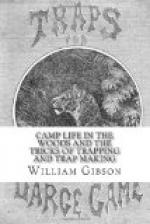It has not been our intention to enter very extensively into [Page 242] the subject of fishing, but only to give such hints as will be found especially useful and practical to the trapper in relation to his food. The above methods, together with those of trolling and fly-fishing, are those most commonly employed by trappers and hunters generally, and we commend them to the amateur.
We give, on page 120, a unique device for the capture of fish, which might also be found useful.
With the above general remarks on the campaign, together with what follows in the detailed articles on the subject, we think that the ground will have been completely covered. Every possible requirement has been anticipated, and every ordinary emergency foreseen and provided against.
THE TRAPPER’S SHELTER.
The life of the professional trapper is a life of hardship and severe exposure, and a man not only requires considerable courage, but also great bodily vigor, in order to combat successfully the dangers of such a wild, adventuresome existence.
The cold and the storm not only imperil his life, but he is often exposed to the attacks of wild beasts. A shelter, therefore, in one form or another, becomes a necessity while it is always a decided comfort, in comparison to a campaign without it.
The reader will find below descriptions of the various shelters alluded to in other parts of this work, and used by trappers throughout the land.
The most substantial of these is the log shanty, commonly known among trappers as the “home shanty,” on account of its being constructed as the only permanent shelter on the trapping line.
It is used as a “home,” a place of rendezvous, and a storehouse for provisions, furs, and other necessities and valuables. Other temporary shelters, known as bark shanties, are also constructed along the trapping lines at intervals of five or ten miles, as resting places. These we describe under the proper title.
Although, to the amateur trapper, the log shanty is not likely to become a necessity, we will nevertheless describe its mode of construction, in order to satisfy our more earnest and adventurous readers, who aspire to a full taste of wild life.
Our illustration gives a very clear idea of such a shanty.
[Page 243] [Illustration: THE HOME SHANTY.]




